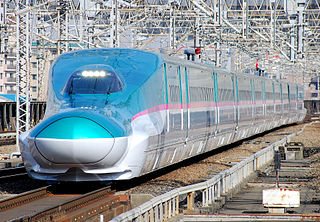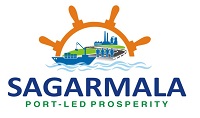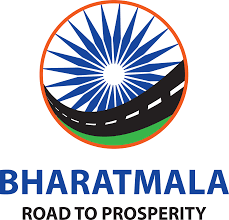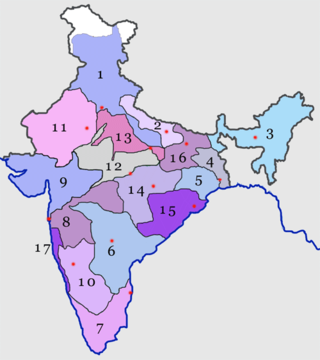Related Research Articles

Transport in India consists of transport by land, water and air. Road transport is the primary mode of transport for most Indian citizens, and India's road transport systems are among the most heavily used in the world.

The Golden Quadrilateral is a national highway network connecting several major industrial, agricultural and cultural centres of India. It forms a quadrilateral with all the four major metro cities of India forming the vertices, viz., Delhi (north), Kolkata (east), Mumbai (west) and Chennai (south). Other major cities connected by this network include Ahmedabad, Bengaluru, Balasore, Bhadrak, Bhubaneswar, Cuttack, Berhampur, Durgapur, Faridabad, Guntur, Gurugram, Jaipur, Kanpur, Pune, Kolhapur, Surat, Vijayawada, Eluru, Ajmer, Visakhapatnam, Bodhgaya, Varanasi, Prayagraj, Agra, Mathura, Dhanbad, Gandhinagar, Udaipur, and Vadodara. The main objective of these super highways is to reduce the travel time between the major cities of India, running roughly along the perimeter of the country. The North–South corridor linking Srinagar and Kanyakumari, and East–West corridor linking Silchar (Assam) and Porbandar (Gujarat) are additional projects. These highway projects are implemented by the National Highway Authority Of India (NHAI). At 5,846 kilometres (3,633 mi), it is the largest highway project in India and the fifth longest in the world. It is the first phase of the National Highways Development Project (NHDP), and consists of two, four, and six-lane express highways, built at a cost of ₹600 billion (US$7.5 billion). The project was planned in 1999, launched in 2001, and was completed in July 2013.

Transport in Chennai includes various modes of air, sea, road and rail transportation in the city and its suburbs. Chennai's economic development has been closely tied to its port and transport infrastructure, and it is considered one of the best infrastructure systems in India.

Dankuni is a city and a municipality of Hooghly district in the Indian state of West Bengal. It is now part of the area covered by Kolkata Metropolitan Development Authority (KMDA). It is considered posh area in Hooghly. Positioned strategically near Kolkata, it has emerged as an important industrial and commercial center in the region. The city's landscape is characterized by a mix of residential areas and industrial zones, reflecting its dual identity as a place of habitation and economic activity.

Indian Railways does not currently have any operational high-speed rail lines, though a total of eight corridors have been approved, with the corridor between Mumbai and Ahmedabad under construction. As of 2023, the fastest train services that operate at speeds of 160 km/h (99 mph) are Gatimaan Express and Rani Kamalapati (Habibganj)–Hazrat Nizamuddin Vande Bharat Express on the Tughlakabad – Agra Cantonment section of the route and the regional RapidX services.
Chennai Monorail was a proposal for a number of lines as part of mass transit system for the Indian city of Chennai. Originally the city planned to use monorail on all lines but many were subsequently changed to railways as part of the Chennai Metro.
The Western Railway Elevated Corridor, also known as the Oval Maidan-Virar elevated corridor, was a proposed rapid transit corridor that would have run along the same alignment as the Western Line of the Mumbai Suburban Railway, and link Oval Maidan with Virar.

Urban rail transit in India plays an important role in intracity transportation in the major cities which are highly populated. It consists of rapid transit, suburban rail, monorail and tram systems. According to a report published in 2021, a total of 2.63 billion people travelled annually in metro systems across India's sixteen major cities, placing the country as one of the busiest urban rapid transit hubs in the world in terms of ridership. The combined length of 895 kilometres of metro systems in India makes it the third longest in operation in the world.
The Western Dedicated Freight Corridor or Western DFC is a 1,506 km long, under-construction 1,676 mm freight corridor in India. It will connect Dadri in Uttar Pradesh with Jawaharlal Nehru Port in Navi Mumbai, Raigad District, Maharashtra. The corridor is being built by the Dedicated Freight Corridor Corporation of India Limited (DFCCIL), a public-sector unit (PSU) under the Ministry of Railways and would be electrified with double-line operation. The Western DFC entails a new single-line branch from Prithla in Palwal district to Tughlakabad in Delhi, running parallel to the existing New Delhi–Faridabad–Palwal railway line.

Eastern Dedicated Freight Corridor or Eastern DFC is a broad gauge freight corridor in India. The railway will run between Ludhiana in Punjab and Dankuni in West Bengal via Meerut and Khurja in Uttar Pradesh. This railway line is one of the multiple freight corridors being constructed by the Dedicated Freight Corridor Corporation of India (DFCCIL), a public-sector unit (PSU) under the Ministry of Railways.

The Sagarmala Programme is an initiative by the Government of India to enhance the performance of the country's logistics sector. The programme envisages unlocking the potential of waterways and the coastline to minimize infrastructural investments required to meet these targets.
The Indian Government is undertaking several initiatives to upgrade its aging railway infrastructure and enhance its quality of service. The Railway Ministry has announced plans to invest ₹5,400,000 crore to upgrade the railways by 2030. Upgrades include 100% electrification of railways, upgrading existing lines with more facilities and higher speeds, expansion of new lines, upgrading railway stations, introducing and eventually developing a large high-speed train network interconnecting major cities in different parts of India and development of various dedicated freight corridors to cut down cargo costs within the country.

The Bharatmala Pariyojna is an ongoing project that will interconnect 550 District Headquarters through a minimum 4-lane highway by raising the number of corridors to 50 and move 80% freight traffic to National Highways by interconnecting 24 logistics parks, 66 inter-corridors (IC) of total 8,000 km (5,000 mi), 116 feeder routes (FR) of total 7,500 km (4,700 mi) and 7 north east Multi-Modal waterway ports. The project also includes development of tunnels, bridges, elevated corridors, flyovers, overpass, interchanges, bypasses, ring roads etc. to provide shortest, jam free & optimized connectivity to multiple places, it is a centrally-sponsored and funded Road and Highways project of the Government of India. This ambitious umbrella programme will subsume all existing Highway Projects including the flagship National Highways Development Project (NHDP), launched by the Atal Bihari Vajpayee government in 1998. Bharatmala is mainly focused on connecting remote areas and satellite cities of megacities such as Bengaluru, Pune, Hyderabad etc. The total investment for 83,677 km (51,994 mi) committed new highways is estimated at ₹10.63 lakh crore (US$130 billion), making it the single largest outlay for a government road construction scheme. The project will build highways from Maharashtra, Gujarat, Rajasthan, Punjab, Haryana and then cover the entire string of Himalayan territories - Jammu and Kashmir, Himachal Pradesh, Uttarakhand - and then portions of borders of Uttar Pradesh and Bihar alongside Terai, and move to West Bengal, Sikkim, Assam, Arunachal Pradesh, and right up to the Indo-Myanmar border in Manipur and Mizoram. Special emphasis will be given on providing connectivity to far-flung border and rural areas including the tribal and backward areas.
Hisar Junction railway station is an A-category railway station, under the Bikaner railway division of North Western Railway zone of Indian Railways, located at Hisar city in Hisar district of Haryana state of India. The station consists of 6 platforms, with 6 broad-gauge mostly electrified tracks of Bathinda–Rewari line and Jakhal–Hisar–Sadalpur line, going in 4 directions at an average speed of 120 km/h. Hisar is one of the 400 stations to be redeveloped with international and private partners for modernization on international standards and optimizing the commercial opportunities.

The rail network in the state of Haryana in India, is covered by five rail divisions under three rail zones: North Western Railway zone, Northern Railway zone and North Central Railway zone.
East-West Dedicated Freight Corridor or East-West DFC is a freight specific railway proposed from Eastern to Western India by Indian Railways. The corridor will run between Dankuni in West Bengal and Palghar in Maharashtra. It was announced by then Railway Minister Suresh Prabhu, while presenting the Railway Budget of India in the fiscal year 2016-17. The Government has indicated that they are likely to use foreign direct investment for funding the project. The project would be undertaken through Public Private Partnership (PPP) model.
The Chennai-Mysuru high speed rail corridor is India's third high-speed rail project after the Mumbai Ahmedabad High Speed Rail Corridor and Delhi Varanasi High Speed Rail Corridor. The 435 km HSR corridor will connect Chennai to Mysuru through 9 stations.

The Dedicated freight corridors in India are a network of broad gauge freight railway lines that solely serve freight trains, thus making the freight service in India faster and efficient. The Dedicated Freight Corridor Corporation of India (DFCCIL) is responsible for undertaking planning, development, mobilisation of financial resources and construction, maintenance & operation of these corridors.
References
- ↑ "Progress in Dedicated Freight Corridor". pib.nic.in. Retrieved 18 April 2016.
- ↑ "Rail Budget 2016: Railways to develop three dedicated freight corridors". www.businesstoday.in. Retrieved 18 April 2016.
- ↑ "Rail Budget 2016: Govt plans 3 more freight corridors through PPP". The Financial Express. Retrieved 18 April 2016.